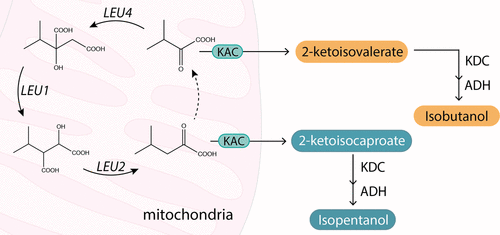当前位置:
X-MOL 学术
›
ACS Synth. Biol.
›
论文详情
Our official English website, www.x-mol.net, welcomes your
feedback! (Note: you will need to create a separate account there.)
Mitochondrial Compartmentalization Confers Specificity to the 2-Ketoacid Recursive Pathway: Increasing Isopentanol Production in Saccharomyces cerevisiae.
ACS Synthetic Biology ( IF 3.7 ) Pub Date : 2020-02-21 , DOI: 10.1021/acssynbio.9b00420 Sarah K Hammer 1 , Yanfei Zhang 1 , José L Avalos 1, 2, 3
ACS Synthetic Biology ( IF 3.7 ) Pub Date : 2020-02-21 , DOI: 10.1021/acssynbio.9b00420 Sarah K Hammer 1 , Yanfei Zhang 1 , José L Avalos 1, 2, 3
Affiliation

|
Recursive elongation pathways produce compounds of increasing carbon-chain length with each iterative cycle. Of particular interest are 2-ketoacids derived from recursive elongation, which serve as precursors to a valuable class of advanced biofuels known as branched-chain higher alcohols (BCHAs). Protein engineering has been used to increase the number of iterative elongation cycles completed, yet specific production of longer-chain 2-ketoacids remains difficult to achieve. Here, we show that mitochondrial compartmentalization is an effective strategy to increase specificity of recursive pathways to favor longer-chain products. Using 2-ketoacid elongation as a proof of concept, we show that overexpression of the three elongation enzymes-LEU4, LEU1, and LEU2-in mitochondria of an isobutanol production strain results in a 2.3-fold increase in the isopentanol to isobutanol product ratio relative to overexpressing the same elongation enzymes in the cytosol, and a 31-fold increase relative to wild-type enzyme expression. Reducing the loss of intermediates allows us to further boost isopentanol production to 1.24 ± 0.06 g/L of isopentanol. In this strain, isopentanol accounts for 86% of the total BCHAs produced, while achieving the highest isopentanol titer reported for Saccharomyces cerevisiae. Localizing the elongation enzymes in mitochondria enables the development of strains in which isopentanol constitutes as much as 93% of BCHA production. This work establishes mitochondrial compartmentalization as a new approach to favor high titers and product specificities of larger products from recursive pathways.
中文翻译:

线粒体区室化赋予了2-酮酸递归途径的特异性:增加酿酒酵母中异戊醇的产量。
递归延伸途径在每个迭代循环中产生的碳链长度增加的化合物。特别令人感兴趣的是衍生自递归伸长的2-酮酸,它们用作有价值的一类先进的生物燃料的前体,这些生物燃料被称为支链高级醇(BCHA)。蛋白质工程学已被用于增加完成的迭代延伸循环的次数,但是仍然难以实现长链2-酮酸的特定生产。在这里,我们表明线粒体区室化是增加递归途径的特异性以支持长链产物的有效策略。使用2-酮酸延伸作为概念证明,我们显示异丁醇生产菌株的线粒体中三种延伸酶LEU4,LEU1和LEU2-的过表达导致2。相对于胞浆中过表达相同的延伸酶,异戊醇与异丁醇产物比率增加3倍,而相对于野生型酶表达增加31倍。减少中间体的损失使我们能够将异戊醇的产量进一步提高至异戊醇的1.24±0.06 g / L。在该菌株中,异戊醇占生产的BCHA总量的86%,同时实现了酿酒酵母报道的最高异戊醇滴度。在线粒体中定位延伸酶能够开发菌株,其中异戊醇占BCHA产量的93%。这项工作建立了线粒体区室化作为一种新方法,以支持递归途径中较大产物的高滴度和产物特异性。
更新日期:2020-02-21
中文翻译:

线粒体区室化赋予了2-酮酸递归途径的特异性:增加酿酒酵母中异戊醇的产量。
递归延伸途径在每个迭代循环中产生的碳链长度增加的化合物。特别令人感兴趣的是衍生自递归伸长的2-酮酸,它们用作有价值的一类先进的生物燃料的前体,这些生物燃料被称为支链高级醇(BCHA)。蛋白质工程学已被用于增加完成的迭代延伸循环的次数,但是仍然难以实现长链2-酮酸的特定生产。在这里,我们表明线粒体区室化是增加递归途径的特异性以支持长链产物的有效策略。使用2-酮酸延伸作为概念证明,我们显示异丁醇生产菌株的线粒体中三种延伸酶LEU4,LEU1和LEU2-的过表达导致2。相对于胞浆中过表达相同的延伸酶,异戊醇与异丁醇产物比率增加3倍,而相对于野生型酶表达增加31倍。减少中间体的损失使我们能够将异戊醇的产量进一步提高至异戊醇的1.24±0.06 g / L。在该菌株中,异戊醇占生产的BCHA总量的86%,同时实现了酿酒酵母报道的最高异戊醇滴度。在线粒体中定位延伸酶能够开发菌株,其中异戊醇占BCHA产量的93%。这项工作建立了线粒体区室化作为一种新方法,以支持递归途径中较大产物的高滴度和产物特异性。











































 京公网安备 11010802027423号
京公网安备 11010802027423号